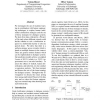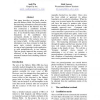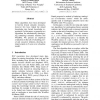110
Voted
ACL
2006
15 years 2 months ago
2006
This paper demonstrates a conceptually simple but effective method of increasing the accuracy of QA systems on factoid-style questions. We define the notion of an inverted questio...
97
Voted
ACL
2006
15 years 2 months ago
2006
In this paper, we discuss how to utilize the co-occurrence of answers in building an automatic question answering system that answers a series of questions on a specific topic in ...
91
Voted
ACL
2006
15 years 2 months ago
2006
This interactive presentation describes LexNet, a graphical environment for graph-based NLP developed at the University of Michigan. LexNet includes LexRank (for text summarizatio...
96
Voted
ACL
2006
15 years 2 months ago
2006
We present an automatic approach to tree annotation in which basic nonterminal symbols are alternately split and merged to maximize the likelihood of a training treebank. Starting...
112
click to vote
ACL
2006
15 years 2 months ago
2006
We investigate the use of machine learning in combination with feature engineering techniques to explore human multimodal clarification strategies and the use of those strategies ...
86
Voted
ACL
2006
15 years 2 months ago
2006
This paper describes an ongoing effort to parse the Hebrew Bible. The parser consults the bracketing information extracted from the cantillation marks of the Masoetic text. We fir...
91
Voted
ACL
2006
15 years 2 months ago
2006
Many algorithms have been developed to harvest lexical semantic resources, however few have linked the mined knowledge into formal knowledge repositories. In this paper, we propos...
101
Voted
ACL
2006
15 years 2 months ago
2006
We introduce the possibility of combining lexical association measures and present empirical results of several methods employed in automatic collocation extraction. First, we pre...
106
click to vote
ACL
2006
15 years 2 months ago
2006
In a new approach to large-scale extraction of facts from unstructured text, distributional similarities become an integral part of both the iterative acquisition of high-coverage...
90
Voted
ACL
2006
15 years 2 months ago
2006
It has previously been assumed in the psycholinguistic literature that finite-state models of language are crucially limited in their explanatory power by the locality of the prob...





